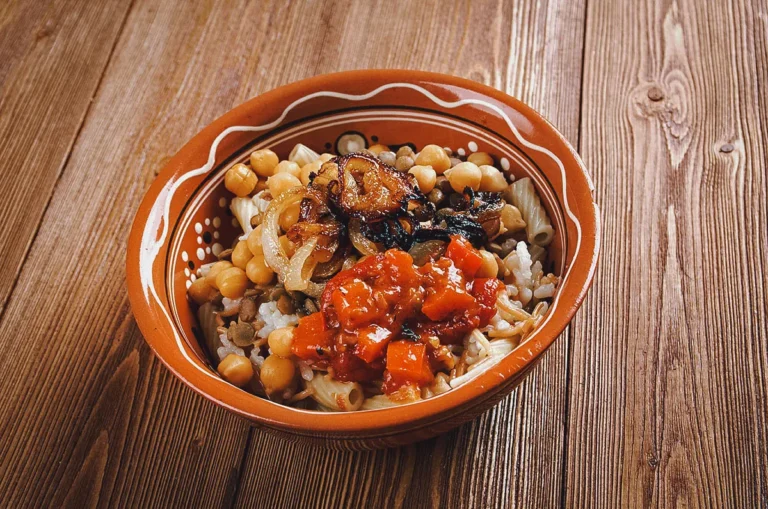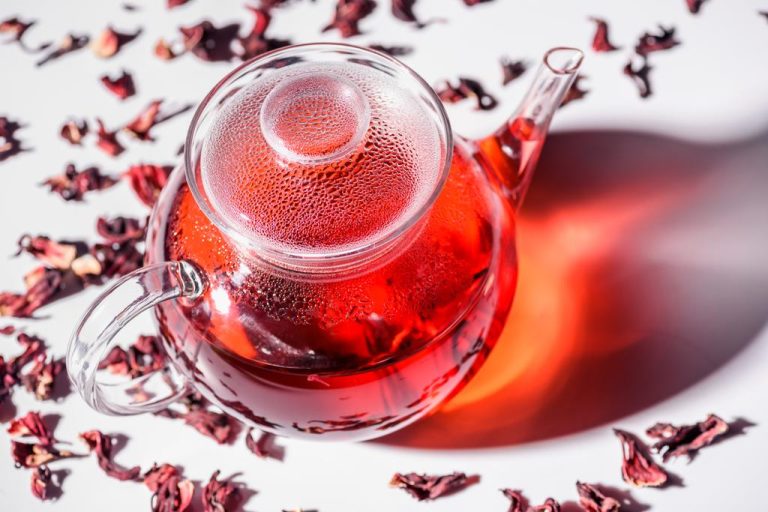Nobody thinks of rosehip or hibiscus when talking about superfood. The two plants that are native to us are quite large suppliers of vitamins and can also be used as medicinal plants in other ways.
Hibiscus – this is what most people associate with images of spring and beautiful, pink or white flowers on ornamental shrubs in gardens. Or potted plants on the balcony, which delight the eye every year. But the plant from the hibiscus family is rarely classified as a superfood.
Hibiscus is edible? Well, not quite, but the flowers come into the (tea) cup more often than expected. And usually together with another, little-noticed fruit: the rosehip. The orange to bright red fruit of the wild rose can be seen everywhere in hedges, forest edges and windbreak belts in late autumn. Nobody seems to be interested in the vitamin C bombs, at most as a decorative element on Advent wreaths and other winter arrangements. It’s a pity really, because the dynamic duo can do more than just bloom pretty in spring and deliver colorful fruit in autumn.
Karkade, the hibiscus plant for tea
Hibiscus belongs to the mallow family (Malvaceae) and is one of an estimated 200 to 675 subspecies. Hibiscus is understood to mean several species, but only Hibiscus sabdariffa is used as a tea and medicinal plant. Other names for this hibiscus species are roselle, karkade or African mallow. In German, the mallow family is actually called marshmallow. However, the old German term for this is only rarely used, mostly in connection with its use in herbal medicine.
Other hibiscus species are often used as ornamental plants in gardens, parks, indoors or on the balcony because of their beautiful, large flowers in spring. The mallow species originally came from Asia, but today the various hibiscus variants can be found in all tropical and subtropical regions of the world. They occur as annual or perennial herbaceous plants, shrubs or trees. The hibiscus (Hibiscus sabdariffa or roselle) used in folk medicine as a medicinal plant is one of the annual, herbaceous representatives. Since the plant comes from warm regions, it is rarely hardy and should therefore overwinter indoors.
Harvesting, processing and use of hibiscus
Hibiscus is harvested when it is in bloom. The hibiscus plant can grow over three meters high and has several large flowers. When the seeds ripen, these change their color to a deep, bright dark red, and the calyx becomes fleshy. This is the ideal time to harvest the hibiscus. The flowers are then dried and stored for further use. Hibiscus blossoms have a pleasant and slightly sour taste and turn an intense red colour. The flowers are therefore a popular addition to desserts, teas, jams, liqueurs or Indian curries. The fibrous components, which can be processed like jute, are obtained from the plant stalks. Hibiscus is therefore often grown in developing countries to reduce dependence on jute imports.
Effect of hibiscus as a medicinal plant
Hibiscus in the Sabdariffa variety is mainly used as a food because of its taste and color. Nevertheless, the flowers contain a lot of vitamin C and are also said to have an expectorant effect. Hibiscus is said to help with colds. This is perhaps still known from the marshmallow candies or the marshmallow tea that grandma always recommended to us when we had a cough. In addition, hibiscus is said to have a circulatory, laxative, appetizing and diuretic effect.
Above all, however, two spectrums of effects of hibiscus have been scientifically examined: the lowering of blood pressure and lipids. Five researchers have found that three cups of tea with hibiscus per day can actually lower high blood pressure. Of course, this is not definitive proof of its effectiveness, but it can be considered a good indication of it. Side effects are not known when consuming hibiscus tea, it is considered a soft drink in Sudan and neighboring regions.
Botanical knowledge about the rosehip
The rose hip, also known as Hägen, Hiefe, Hiffen, Hetscherl or Hetschepetsche, is the fruit of all types of roses, regardless of whether they are cultivated roses or wild roses. These are not real fruits, but aggregate fruits. They serve as a sort of natural receptacle for the hairy, barbed seeds (nutlets).
Although all species of roses produce rosehips, what we commonly mean by “rosehip” is the fruit of the wild dog rose (Rosa canina). This rose species is the most widespread wild rose in Europe. It usually grows in hedges – this is also in the rosehip with the word part “Hage”. The climbing plant, which can grow up to five meters high and 300 years old, grows on almost all soils except in the mountains. In spring it blooms with small, non-double roses. In autumn it forms the characteristic, orange to bright red fruits – the rose hips.
Harvesting and use of the rosehip
The rose hip is non-toxic and can be eaten both raw and processed. If the fruits remain on the bush, they are extremely durable and often still edible in spring. The false fruits have to be harvested by hand. A ripe rose hip can be easily removed from the stalk – so you can be sure to pick only ripe fruit. In principle, the harvest time for rose hips begins around mid-October and lasts until the end of March. After the first frost, the rosehip releases a particularly large amount of sugar and then tastes sweeter.
You can collect rose hips almost anywhere. But make sure that there is not a field right next to it that has been treated with sprays and pesticides. You should also avoid picking them next to busy roads.
You can use the rosehip with or without nuts either fresh, as rosehip tea, rosehip oil or in various recipes. And there is another “use” that you may know from your childhood: Because of the barbs on the seeds, an “itching powder” can also be made from the rosehip.
Jam and other recipes with rosehip
Rosehip jam is an excellent change at the breakfast table and very rich in vitamin C. To do this, the rosehips are halved and the nuts are completely removed, otherwise they would be quite annoying when eaten. The outer shells are then cooked into jam like any other fruit. Other ideas for cooking with the rosehip are, for example, a rosehip soup, rosehip liqueur or pickled fruit.
Rosehip oil makes you beautiful
Rosehip oil can also be extracted from the rosehip. To do this, the real seeds of the rosehip are mechanically pressed or the oil is chemically extracted. Stored in a cool, dark place and usually stabilized with vitamin E, the light yellow to orange-red oil will keep for about a year. Rosehip oil is particularly effective against dry, chapped skin and for wound healing. It is therefore used both medicinally, for example for psoriasis (psoriasis) and burns, and in cosmetics, for example in anti-wrinkle creams.
Rosehip tea, the classic
The most well-known use of the rosehip is certainly the rosehip tea. For one cup, pour hot water over about 2 g of dried fruit and let it steep for a few minutes. The tea made from the rosehip tastes pleasantly refreshing and sour, which is why the fruits are also often used as a flavor enhancer in teas. But was on the vitamin C of the rosehip as a remedy for colds, which is wrong with the tea. On the one hand, the vitamin C content decreases significantly with storage. On the other hand, the vitamin is not heat-resistant. Rosehip jam or jelly or fresh fruit work better here.
What is the effect of rosehip?
So what effect does the rose hip have? Is Rosehip Really Healthy? The fruits are healthy when they are not full of pesticides or exhaust fumes, but definitely when they are fresh. They are full of vitamin C and also contain various fruit acids, pectins, carotenoids and tannins. Overall, the rosehip has an antioxidant effect. It was found that the pseudopods of the rose bush have a positive effect on blood pressure and cholesterol levels.
According to a meta-study, rosehip also promises relief from osteoarthritis. This is probably due to the fruit acids, but needs more research. Perhaps this can be observed in animal “test objects” – the rosehip has been used for many years as an accompanying therapy for horses with problems in the joints.
Where can I buy hibiscus and rose hips?
It is best not to buy the rosehip, but collect it yourself from suitable places. If you need the red pseudopods in larger quantities, you can buy them dried in health food stores, organic shops, drugstores, pharmacies and of course in various online shops. Since the hibiscus for tea does not grow in our latitudes, it has to be bought dried and cut. You can get it wherever rose hips are sold.
Of course you can also put a hibiscus plant in the living room, but the flowers don’t last very long. When buying rosehip and hibiscus, the most important thing to look for is organic quality – nobody wants sprays and pesticides in the tea. With rosehip, you should also pay attention to the origin. By the way, there are also hibiscus from German greenhouses. A look at the label reveals the origin and helps to minimize the ecological footprint.

Summary of the dynamic tea duo
Both the hibiscus and the rosehip are not superfoods in the strict sense. But tea made from it tastes good, refreshes and can boost the immune system and metabolism. Fresh rose hips also have a possible anti-arthritis effect and a high vitamin C content. All in all, the two underestimated plants are worth trying and relatively harmless from an ecological point of view.







